Deep Venous Thrombosis of the Lower Limbs
Lower limb deep venous thrombosis (DVT) is a condition in which fresh thrombus (blood clot) forms in the deep veins of the legs and pelvis. Besides causing local symptoms including calf pain, swelling and oedema, thrombus in the lower limb veins is also a source of emboli that may lead to life-threatening pulmonary embolism (PE).
DVT and consequently PE are most commonly seen in patients with reduced mobility and underlying medical illness. Immobilisation, surgery in the past 3 months, stroke, previous history of venous thromboembolism and malignancy are the most important risk factors. The incidence of DVT also increases exponentially with age. In patients with extensive or recurrent DVT/PE (especially under 50 years of age), genetic prothrombotic disorders such as factor V Leiden mutation, excess factor VIII, antithrombin 3 deficiency, protein C and S deficiencies are often present. Other important risk factors include the oral contraceptive pill, smoking, obesity and hypertension. ‘Economy class syndrome’ (or traveller’s thrombosis) is rare occurring in one in 400 000 passengers in flights longer than 8 hours. An increased risk of thrombosis has not yet been confirmed in flights of less than 4 hours.
The likelihood that a patient with a history of DVT will presentwith repeat symptoms within 1 year is reported to be as highas 20%. Repeat symptoms are largely determinedby the extent of venous reflux, the presence of persistent poplitealobstruction, and the rate of recanalization, all of which maydetermine the presence of postphlebitic syndrome. Postphlebiticsyndrome is caused by impaired venous valve function from priorthrombosis. Particularly in the erect position, the retrogradevenous flow leads to chronic venous hypertension, which inducessuperficial varicosities, chronic swelling, hyperpigmentationfrom stagnant red blood cell breakdown, and in severe casesulceration.
In patients with symptoms of lower limb DVT or PE, the diagnosis of DVT is routinely established withvenous ultrasound (US). Compression venous US is the venousprocedure of choice in patients with suspected DVT as it is non-invasive and has a high sensitivity (95%) and specificity (98%). The principle of compression venous US is simple; normal veins compress fully so that the anterior and posterior walls touch under pressure of the examining probe (Fig 1), while those containing thrombus do not (Fig 2). Colour and Spectral Doppler ultrasound are also used to detect flow patterns in the common femoral (Fig 3) and popliteal arteries; abnormal flow patterns in these veins indicate pelvic and more distal calf vein thrombosis respectively. Abnormal flow patterns on Doppler ultrasound include lack of flow, lack of phasic variation with respiration, and lack offlow during calf compression; all are indirect signs of more proximal or distal venous occlusion.
In patients with a history of DVTwho present with recurrent symptoms due to postphlebitic syndromeor recurrent DVT, US may in some cases not distinguish acute thrombus from prior or chronic thrombus. In addition,a non-occlusive clot may go undetected because of its location,small size, and non-occlusive nature. X-ray venography is invasive and technically very difficult, while having limited accuracy due to incomplete venous filling with contrast particularly in the calf. X-ray venography has been largely replaced by US.
New scintigraphic techniques may assist in distinguishing post-thrombotic change from fresh thrombosis. Theradiopharmaceutical technetium-99m apcitide is a complex of the radionuclide Tc-99m andthe small synthetic peptide apcitide. Apcitide binds toglycoprotein IIb/IIIa receptors, which are expressed on thesurface of activated platelets, making the radiopharmaceuticalspecific for acute thrombi but not chronic thrombi. These attributes may make Tc-99m apcitide imaginga potential complementary test for differentiation of acutefrom chronic DVT and detection of segmental DVT that is occultat US in selected patient populations (Fig 4).
The prevalence of postoperative DVT has been reported to beas high as 60% in patients who have undergone arthroplasty.This high prevalence has led to prophylaxis with postoperativeanticoagulation therapy, pneumatic leg compression and earlyphysiotherapy and in some institutions routine ultrasound is used to detect subclinical DVT. Administration of heparin, warfarin,or low-molecular-weight heparin may make US visualization of athrombus more difficult because the thrombus may be segmental,hypo-echoic, and less likely to occlude the lumen. Tc-99m apcitide scanning may be helpful in these patients if they have a positive ventilation/perfusion scan. A more efficient way to evaluate PE and DVT simultaneously is with spiral CT. Rapid consecutive post-intravenous contrast spiral CT scanning of the pulmonary arteries followed by the lower limb veins has been shown, can confirm the presence of both PE and DVT in a single exam (Fig 5).
Another situation in which diagnosis of acute DVT is problematicis isolated calf vein thrombus. Eighty-eight percent of calf thrombioccur in the asymptomatic population. Isolatedcalf vein thrombus is rarely a cause of pulmonary embolism.US can be used for direct detection of calf thrombi or for assessmentof propagation into the femoral-popliteal system, which occursin approximately 20% of patients.
In summary, there are a number of imaging studies available to help us detect DVT in patients at risk and in those with evidence of PE. Venous UShas been used clinically for over 2 decades with hundreds of published studies confirming is validity. Despite the shortcomings of venous US in some cases ofchronic DVT and following arthroplasty,no body of knowledge exists that unequivocally points to replacingvenous US in day-to-day clinical practice. Tc-99m apcitideimaging may have a role in cases with equivocal US findings. SpiralCT is useful in patients with clinically suspected PE, as it will confirm PE and identify the source of emboli (DVT) in one sitting; however, larger studies will be required to statistically confirm the efficiency of this technique.
Figure Legends:
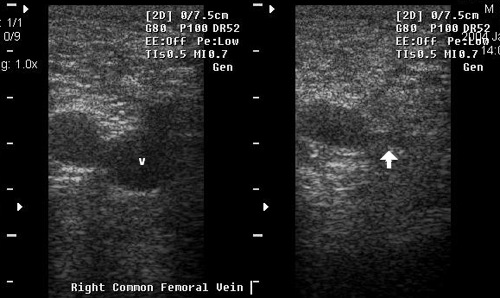
Figure 1: Transverse scan through a normal right common femoral vein (CFV): (a) without compression the lumen of the CFV (v) is visible, while (b) with compression the lumen disappears (arrow).
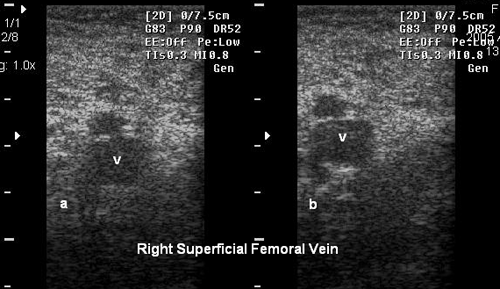
Figure 2: Transverse scan through a thrombosed left CFV: (a) without compression the lumen of the CFV is visible, and remains visible with compression (b).
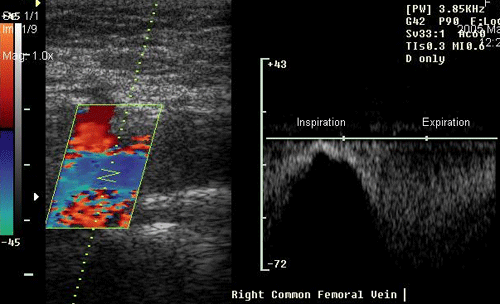
Figure 3:Normal phasic flow in the right CFV during respiration.
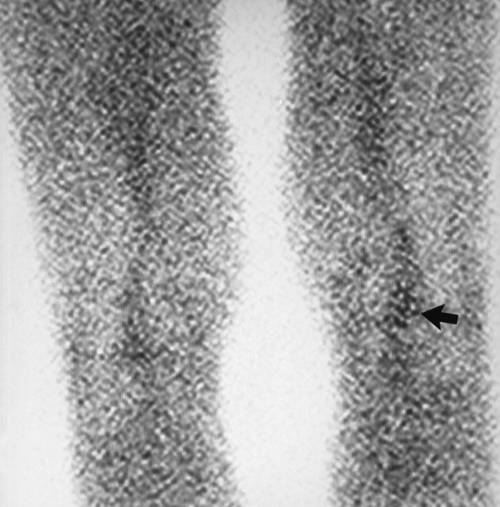
Figure 4: Tc-99m apcitide showing tracer accumulation (arrow) consistent with acute thrombus in the right popliteal vein .
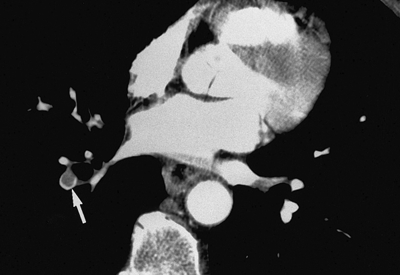
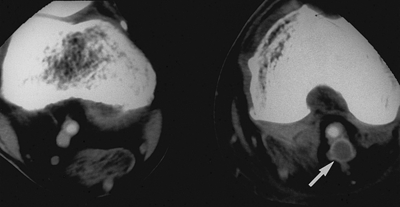
Figure 5: Spiral CT scans following a single injection of IV contrast material showing (a) PE (arrow) and (b) left popliteal vein DVT (arrow).

